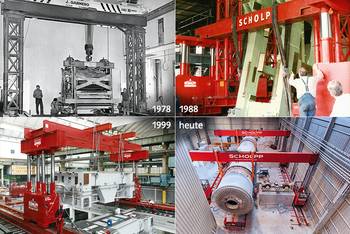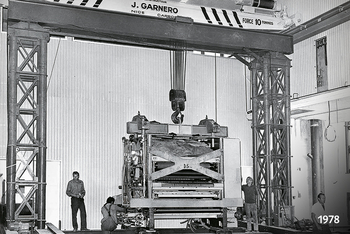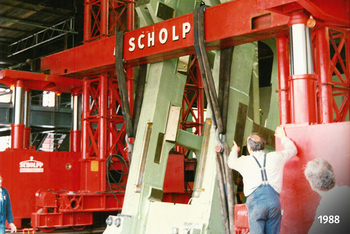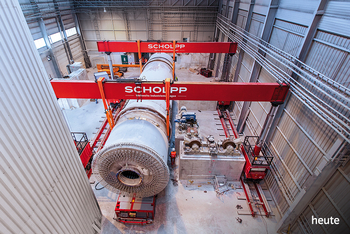SCHOLPP was a pioneer in the use of lifting gantries
As with so many inventions, the development of lifting gantry technology began with a vision: what would it be like to have adaptable lifting technology for any situation? SCHOLPP launched the first mechanical lifting gantry on the market in 1972. Experience gained from everyday projects led to the next idea: flexible lifting portals. This gradually gave rise to an agile technology that can be adapted to suit local conditions in terms of lifting height, span, and lifting power. With this, SCHOLPP revolutionized the industrial installation market in 1987. It was the first installation specialist company in Europe to use a hydraulic lifting portal.
Today, SCHOLPP has a total of 46 hydraulic lifting gantry rigs in Germany, and 16 more in locations worldwide. These lifting gantry rigs are modular and can be combined to form complex lifting portals with up to 1,000 tons load capacity. Cable-pull and aluminum portals of various sizes and load capacities round out the range of equipment.
Technical limits in the use of truck-mounted cranes
Lifting gantries have many advantages over truck-mounted cranes in industrial installations. Cranes reach their limits in various situations where lifting gantry systems can overcome them thanks to their structural compactness, variability, and enormous load capacity.
Crane assembly may be impossible in enclosed industrial buildings where there is not enough space to extend the boom. Limited space at the entrance to factory buildings is another factor that often prevents crane-based operations. Particularly high-weight loads require cranes with correspondingly large horizontal and vertical space requirements. Most indoor settings and production environments simply do not allow this. Crane supports may far exceed the permissible floor load in factories due to very high localized pressures when lifting large machine components. Most production facilities are not designed for these high loads.
For real precision landings: positioning with millimeter accuracy
Three decades after the first hydraulic lifting gantry, the latest generation of this lifting technology is now in use. High lift at low overall height, maximum flexibility and intelligent control technology – these are the hallmarks of the new lifting gantry generation. Three-stage hydraulic cylinders with integrated controls provide these benefits for installations in tight spaces. The electronic synchronization control system ensures a precise, even extension of all hydraulic cylinders that are combined into a portal. This means loads are positioned with extreme sensitivity and absolute precision.




